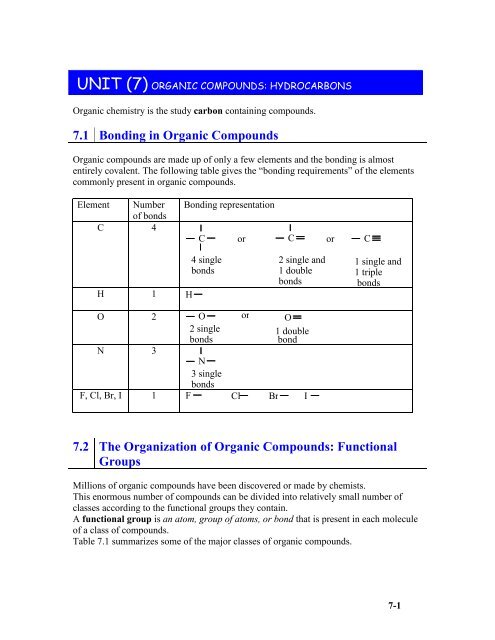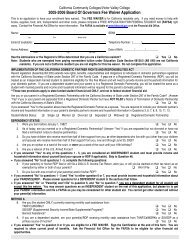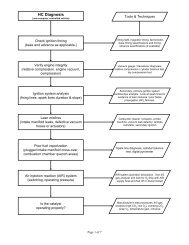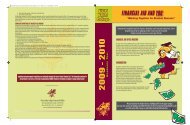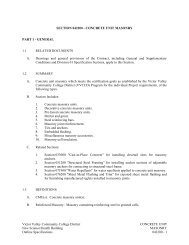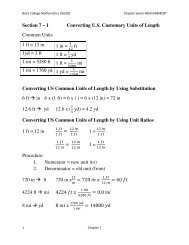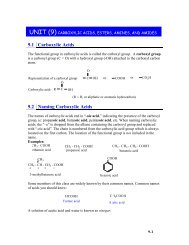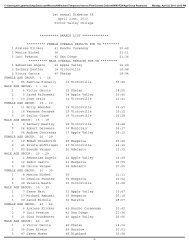unit (7) organic compounds
unit (7) organic compounds
unit (7) organic compounds
Create successful ePaper yourself
Turn your PDF publications into a flip-book with our unique Google optimized e-Paper software.
Worked Example 7-2Draw all structural isomers of C 6 H 14 .Solutioncontinuous chainCH 3 - CH 2 - CH 2 - CH 2 - CH 2 -CH 3branched chainsCH 3CH 3CH 3 - CH - CH 2 - CH 2 - CH 3CH 3 - CH 2 - CH - CH 2 - CH 3CH 3CH 3 - CH - CH - CH 3CH 3 CH 3CH 3 - C - CH 2 - CH 3CH 37.4 IUPAC Naming of Branched-Chain AlkanesWhen naming branched-chain alkanes, we must name the branch(s) that are attached tothe main-chain. If the branches (substituted groups) are smaller chain hydrocarbons theyare called alkyl groups.An alkyl group is a group derived by removing a single hydrogen atom from an alkanemolecule, thus creating a point of attachment. The letter “R” is used as a general symbolfor alkyl groups.AlkaneAlkyl -Rmethane(CH 4 ) methyl-CH 3ethane(CH 3 CH 3 )ethyl-CH 2 CH 3propane(CH 3 CH 2 CH 3 )propyl-CH 2 CH 2 CH 3isopropylCH 3 CHCH 37-6
IUPAC Rules for Naming Branched-Chain AlkanesI) An Alkane With Only One Branch1. Determine the name of the parent chain, the longest continues carbon chain in thealkane.2. The parent chain is numbered from the end nearest to the alkyl group. Give thealkyl group (the branch) a name and a number. Use a hyphen to connect thenumber to the name.3. Write the name as single word.Worked Example 7-3Name the following alkane:SolutionCH 3CH 3 - CH 2 - CH - CH 2 -CH 2 -CH 2 -CH 31. The longest continuous chain contains seven carbon atoms (heptane).2. There is one methyl group on the chain on carbon 3. “3-methyl” (Thenumbering must be from the left to give the lowest number to the branch).3. The correct name is 3-methylheptane.II) An Alkane With More Than One BranchWhere Branches Are Identical1. Determine the name of the parent chain, the longest continuous carbon chain in thealkane.2. The parent chain is numbered from the end nearer the first alkyl group. Give eachalkyl group a name and a number. Use hyphens to separate the numbers from thedifferent prefixes and commas to separate numbers. If two or more identical alkylsare present, use one of the prefixes di-, tri-, tetra-, and so forth, to the name of thealkyl.3. Write the name as single word.7-7
Worked Example 7-4Name the following alkane:CH 3CH 3CH 3 - CH - C - CH 2 - CH- CH 2 -CH 3CH 3 CH 3Solution1. The longest continuous chain contains seven carbon atoms (heptane).2. There are four methyl groups on the chain. Two methyl groups are on carbon 3,one CH 3 on carbon 2, and one CH 3 on carbon 5.3. The correct name is 2,3,3,5-tetramethylheptane.III) An Alkane With More Than One BranchWhere Branches Are Different1. Determine the name of the parent chain, the longest continues carbon chain in thealkane.2. The parent chain is numbered from the end nearer the first alkyl group. Give eachalkyl group a name and a number. Use hyphens to separate numbers from words; usecommas to separate numbers. If different alkyl groups are present, write them inalphabetical order. If necessary, use one of the prefixes di-, tri-, tetra-, and so forth,but don’t use them for alphabetizing purposes.3. Write the name as single word.Worked Example 7-5Name the following alkane:SolutionCH 2 CH 3CH 3 - CH - CH - CH- CH 2 - CH 2 -CH 3CH 3 CH 31. The longest continuous chain contains seven carbon atoms (heptane).2. There are three branches. Two methyl groups on carbon 2 and 3; one ethylgroup on carbon 4. Write the alkyl groups in alphabetical order (ethyl beforemethyl).3. The correct name is 4-ethyl-2,3-dimethylheptane.7-8
Practice 7-2Name each the following <strong>compounds</strong>:a)Answerc)CH 3CH 2 - CH -CH 2 CH 3CH 2 - CHCH 3CH 3CHCHCHCH 3CH 3 - 3b) CH 3 CH 2 2 CH 3CH 3 CH 2 CHCHCH 2 CHCH 2 CH 2 CH 3CH 3a) 3-methylpentaneb) 3,4-dimethylhexanec) 3-ethyl-4,6-dimethylnonanePractice 7-3Draw structure for each of the following <strong>compounds</strong>:a) 3-ethyl-2-methylhexane b) 2,2,5-trimethylheptanec) 4,6-diethyl-6-methylnonane d) 4-ethyl-4-isopropyloctaneAnswerCH 3CH 3CH 2 CH 3a) CH 3 - CH - CH -CH 2 - CH 2 - CH 3 b) CH 3 - C - CH 2 -CH 2 - CH - CH 2 - CH 3CH 3 CH 3c)CH 2 CH 3CH 3CH 3 - CH 2 - CH 2 -CH - CH 2 - C - CH 2 - CH 2 - CH 3CH 2 CH 3CH 3 CHCH 3d) CH 3 - CH 2 - CH 2 -C - CH 2 - CH 2 - CH 2 - CH 3CH 2 CH 37-9
7.5 CycloalkanesA cycloalkane is an alkane in which carbon atoms are connected to one another in acyclic (ring) arrangement. Cycloalkanes have two fewer hydrogen atoms than thecorresponding alkanes.Cycloalkanes are commonly represented using geometric formulas in which each cornerof the figure represents a carbon atom and its attached hydrogen atoms.HHHCCHHCCHHHcondensed formulageometric formulaSubstituted cycloakanes are named by identifying and numbering the position of groupson the ring, followed by the name of the parent cycloalkane.The ring numbering begins with the carbon attached the the first carbon alphabeticallyand proceeds around the ring in the direction that will give the lowest numbers for thepositions of the other attached groups.CH 2 CH 3CH 3CH 3 CH2 CH 313CH 2 CH 2 CH 31 3211-ethyl-3-propylcyclohexane 1,2-dimethylcyclohexane 1-bromo-3-ethylcyclohexaneThe position of single attached group does not need to be specified in the name becauseall positions in the ring are equivalent.BrCH 2 CH 3CH 3ethylcyclohexanemethylcyclohexane7-10
Worked Example 7-6Draw the geometric formula for each of the following:a) 1-ethyl-2-methylcyclobutaneb) 1-methyl-2-propylcyclopentanec) 1,3,5-triethylcyclohexaneSolutiona)CH 2 CH 3CH 3b)CH 3CH 2 CH 2 CH 3CH 2 CH 3c)CH 3 CH 2CH 2 CH 37.6 Reactions of Alkanes1. Combustion is a reaction between a substance and oxygen (usually from air) thatproceeds with the evolution of heat and light.alkane + oxygen → carbon dioxide + water + energyCH 4 + 2O 2 → CO 2 + 2H 2 O + energyWorked Example 7-7Write a balanced equation for the combustion of pentane.SolutionC 5 H 12 + 8O 2 → 5CO 2 + 6H 2 O + energy7-11
2. Halogenation is a reaction between a substance and a halogen (group VIIA) inwhich one or more halogens are incorporated into molecules of a substance.alkane + halogen → halogenated alkane + hydrogen halideCH 4 + Cl 2 → CH 3 Cl + HCl (Light or heat is needed for the reaction.)Nomenclature of Halogenated AlkanesHalogen atoms are called fluoro- (F), chloro- (Cl), bromo- (Br), or iodo- (I).Practice 7-4Draw structural formula for each of the following:a) 2,3-dichloropentane b) 2-bromo-3,4-difluorohexanec) 1,1-diiodocyclobutane d) 1,2-dibromo-3-methylcyclohexaneAnswerCl ClBr F Fa) CH 3 - CH - CH - CH 2 - CH 3b) CH 3 - CH - CH - CH - CH 2 - CH 3Ic) Id)BrBrCH 37.7 Alkenes and AlkynesAlkenes and alkynes are unsaturated hydrocarbons because their molecules do notcontain the maximum possible number of hydrogen atoms.Alkenes are hydrocarbons that have at least one carbon-carbon double bond (-C=C-).General formula for alkenes: C n H 2nAlkynes are hydrocarbons that have at least one carbon-carbon triple bond (-C≡C-).General formula for alkynes: C n H 2n-27-12
7.8 Naming Alkenes and AlkynesAlkenes and alkynes are named similar to the IUPAC rules used for naming alkanes.Guideline:• The parent name is the longest chain that has carbon-carbon multiple bond.• Number from the end closest to the multiple bond.• Names of alkenes end with “ene” and alkynes end with “yne”.CH 3 - CH = CH - CH 2 - CH 32-penteneCH 3 - C C - CH 2 - CH 2 - CH 3 2-hexyneCH 3CH 3CH 3 - CH - CH = CH - CH - CH 32,5-dimethyl-3-hexeneCH 2 - CH 3CH 3 - C C - CH - CH 2 - CH 2 -CH 34-ethyl-2-heptynecyclopenteneCH 33,6-dimethylcyclohexeneCH 37-13
Practice 7-5Give the IUPAC name for each of the following:CH 2 - CH 3a) CH 2 = CH -CH 2 - CH 3 b) CH 3 - CH 2 -CH 2 - C = CH 2CHCH 3 CH 33c) d) CH 3 - C C - CH - CH - CH - CH 3AnswerCH 3a)1-buteneb) 2-ethyl-1-pentenec) 3-methylcyclohexene d) 4,5,6-trimethyl-2-heptyneCommon Names (non-IUPAC Names)A small number of <strong>organic</strong> <strong>compounds</strong> have common names (non-IUPAC) that are usedalmost exclusively to identify them. These <strong>compounds</strong> are usually the smallest membersof a particular class often containing only a few carbons. You need to be familiar to thesenames.CH 2 = CH 2 HC ≡ CHIUPAC name ethene ethyneCommon name ethylene acetylene7.9 Geometric IsomersUnlike alkanes, there is no free rotation around a carbon-carbon double bond in alkenes.If both carbons of the double bond have two different groups attached, cis and transisomers exist.Cis isomer: two substituted groups are on the same side of double bond.Trans isomer: two substituted groups are on opposite sides of double bond.7-14
Consider ethene:HHCCHHIf one of the hydrogen atoms attached to each of the carbon atoms in ethene is replacedby a bromine atom, two distinct <strong>compounds</strong> are formed:BrCCBrBrCCHHHHBrcis-1,2-dibromoethene(bromines on same side)trans-1,2-dibromoethene(bromines on different sides)This type of isomerism is called cis-trans isomerism. The prefix cis- and trans- arederived from the Latin; cis- “on this side” and trans- “across.”Worked Example 7-8Give the name of the following alkenes, using cis or trans.CH 3C = CCH 2 CH 3CH 3C = CH H HCH 2 CH 3(a)(b)Solutiona) The longest chain has 5 carbons with the double bond starts at carbon 2.The name is 2-pentene. The two identical groups (the hydrogen atoms) are onthe same side of the double, so we use the prefix “cis”.The full name is cis-2-pentene.b) The longest chain has 5 carbons with the double bond starts at carbon 2.The name is 2-pentene. The two identical groups (the hydrogen atoms) are onthe opposite side of the double bond, so we use the prefix “trans”.The full name is trans-2-pentene.H7-15
7.10 Reactions of AlkenesThe most common reactions of alkenes are addition reactions. In an addition reaction,the double bond is broken and a single bond is formed at each carbon to new atoms orgroups of atoms.A generalized addition reaction is shown here:ABC = C + A BC C1) Addition of H 2 : HydrogenationC = C + H HcatalystHCHC2) Addition of Cl 2 or Br 2 : HalogenationClClC = C + Cl ClCC3) Addition of H 2 O: Hydrationacid (H + )C = C + H OHC CHOH7-16
Worked Example 7-9Give the <strong>organic</strong> product formed in each of the following reactions:CH 3 - CH = CH - CH 3+H 2catalystCH 3 - CH = CH - CH 2 - CH 3+Cl 2+H 2 OSolutionCH 3 - CH = CH - CH 3 + catalyst CH 3 - CH 2 - CH 2 - CH 3H 2CH 3 - CH = CH - CH 2 - CH 3+Cl 2ClClCH 3 - CH - CH - CH 2 - CH 3+H 2 OOHH7.11 Aromatic CompoundsThe simplest aromatic compound is called benzene, molecular formula C 6 H 6 . A benzenemolecule is a ring containing six carbon atoms with a single hydrogen atom attached toeach carbon. Each carbon has one single bond and one double bond to neighboringcarbon atoms.Benzene:HCHCCHHC CHCHororFor convenience, we write the structure of benzene in the following abbreviated form:The circle in the center of the ring represents the six shared electrons (three doublebonds.)7-17
The word aromatic originally referred to the unpleasant odor characteristic to many ofthese substances, but this meaning is not in use anymore.Naming Benzene DerivativesWhen one or more hydrogen atoms of the benzene ring is replaced with other groups, thecompound is named as a derivative of benzene.Examples:CH 2 CH 3 Br ClNO 2ethylbenzenebromobenzene chlorobenzenenitrobenzeneThe IUPAC system retains the common names for the following:CH 3 OHNH 2COOHtoluene phenol aniline benzoic acidWorked Example 7-10Draw the structural formula for each of the following:a) 1,3-dichlorobenzeneb) 2,4,6-trinitrotoluene (TNT)c) 2-bromo-3,4-dichlorophenolSolutionClO 2 NCH 3NO 2OHBrClNO 2Cla) b)c)Cl7-18
Homework Problems7.1 Write condensed structures for each of the following <strong>compounds</strong>:a. 2,2,4-trimethylpentaneb. 5-isopropyl-2-methyloctanec. 1,1,3,3-tetrabromopropaned. 1,1-dichlorocyclopentanee. 1,4-diethylcyclohexanef. 1-bromo-2-methylcyclobutane7.2 What are the IUPAC names of the following <strong>compounds</strong>?CH 3 CH 2CH 3 CH 2 CH 3a) CH 3 CH 2 C CH 2 CHb)CH 3 CH 2CH 3CH 2 CH 3c) d)(CH 3 ) 3 CCH 2 CH 3e) f)F Br Br7.3 Write the structural formulas and names for FOUR isomers of cycloalkane,C 5 H 10 .7.4 Propose structures for molecules that fit the following descriptions:a. an alkene with three carbonsb. an alcohol with two carbonsc. an ether with three carbonsd. an amine with four carbonse. a three-carbon esterf. a ketone with four carbonsg. a four-carbon carboxylic acidh. a cycloalkene with six carbons7-19
7.5 Write equations for the reaction of cyclopentene with each of the following:a. H 2 and Pd catalystb. Br 2c. H 2 O and H 2 SO 4 catalyst7.6 Write a structural formula for each of the following:a. cis-3-hepteneb. trans-3-heptenec. 1,1-dibromo-2,2-dichloroethened. 1,2-dibromo-1,2-dichloroethenee. 4-methyl-2-hexynef. 3-ethyl-1-heptyneg. 1,2-dimethylcyclopenteneh. trans-2,5-dimethyl-3-hexenei. diisopropylacetylene7.7 Name the following <strong>compounds</strong>:CH 3a)Ib)OHNH 2Br Brc) d)COOHClC 2 H 5C 2 H 5BrFCH 2 CH 2 CH 3F Fe) f)FFFCH 3 CHCH 37-20


